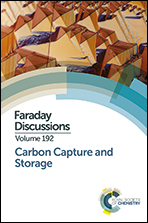Kinetics of carbonate mineral dissolution in CO2-acidified brines at storage reservoir conditions†
Abstract
We report experimental measurements of the dissolution rate of several carbonate minerals in CO2-saturated water or brine at temperatures between 323 K and 373 K and at pressures up to 15 MPa. The dissolution kinetics of pure calcite were studied in CO2-saturated NaCl brines with molalities of up to 5 mol kg−1. The results of these experiments were found to depend only weakly on the brine molality and to conform reasonably well with a kinetic model involving two parallel first-order reactions: one involving reactions with protons and the other involving reaction with carbonic acid. The dissolution rates of dolomite and magnesite were studied in both aqueous HCl solution and in CO2-saturated water. For these minerals, the dissolution rates could be explained by a simpler kinetic model involving only direct reaction between protons and the mineral surface. Finally, the rates of dissolution of two carbonate-reservoir analogue minerals (Ketton limestone and North-Sea chalk) in CO2-saturated water were found to follow the same kinetics as found for pure calcite. Vertical scanning interferometry was used to study the surface morphology of unreacted and reacted samples. The results of the present study may find application in reactive-flow simulations of CO2-injection into carbonate-mineral saline aquifers.
- This article is part of the themed collection: Carbon Capture and Storage

 Please wait while we load your content...
Please wait while we load your content...